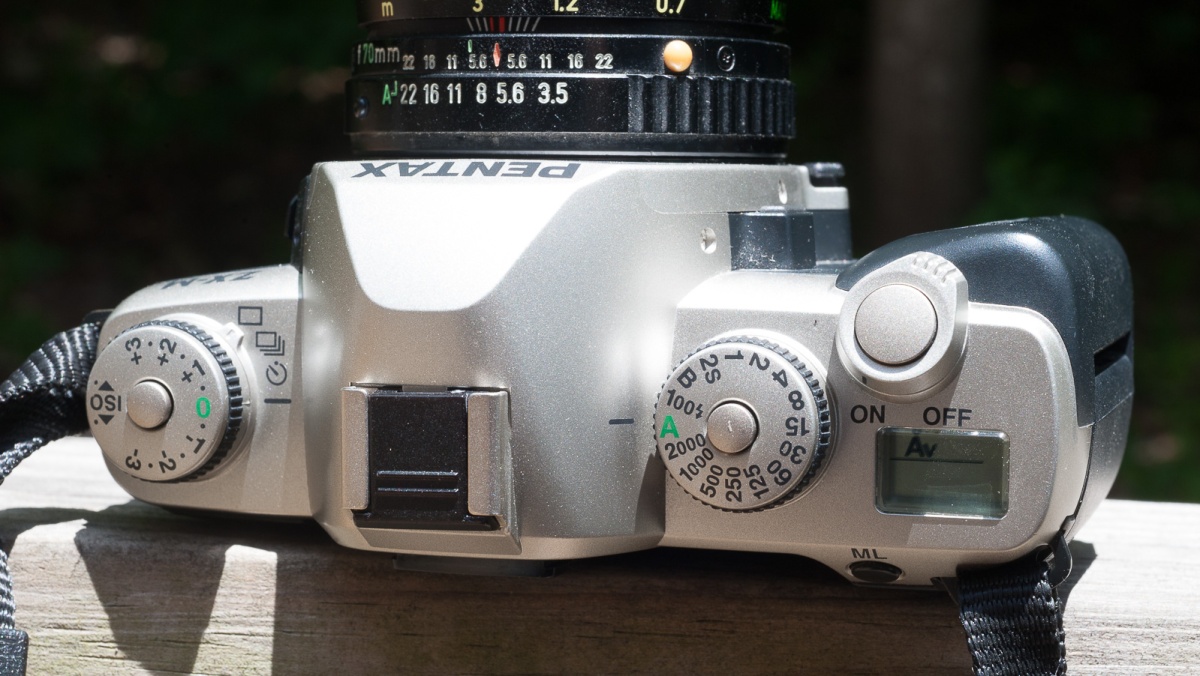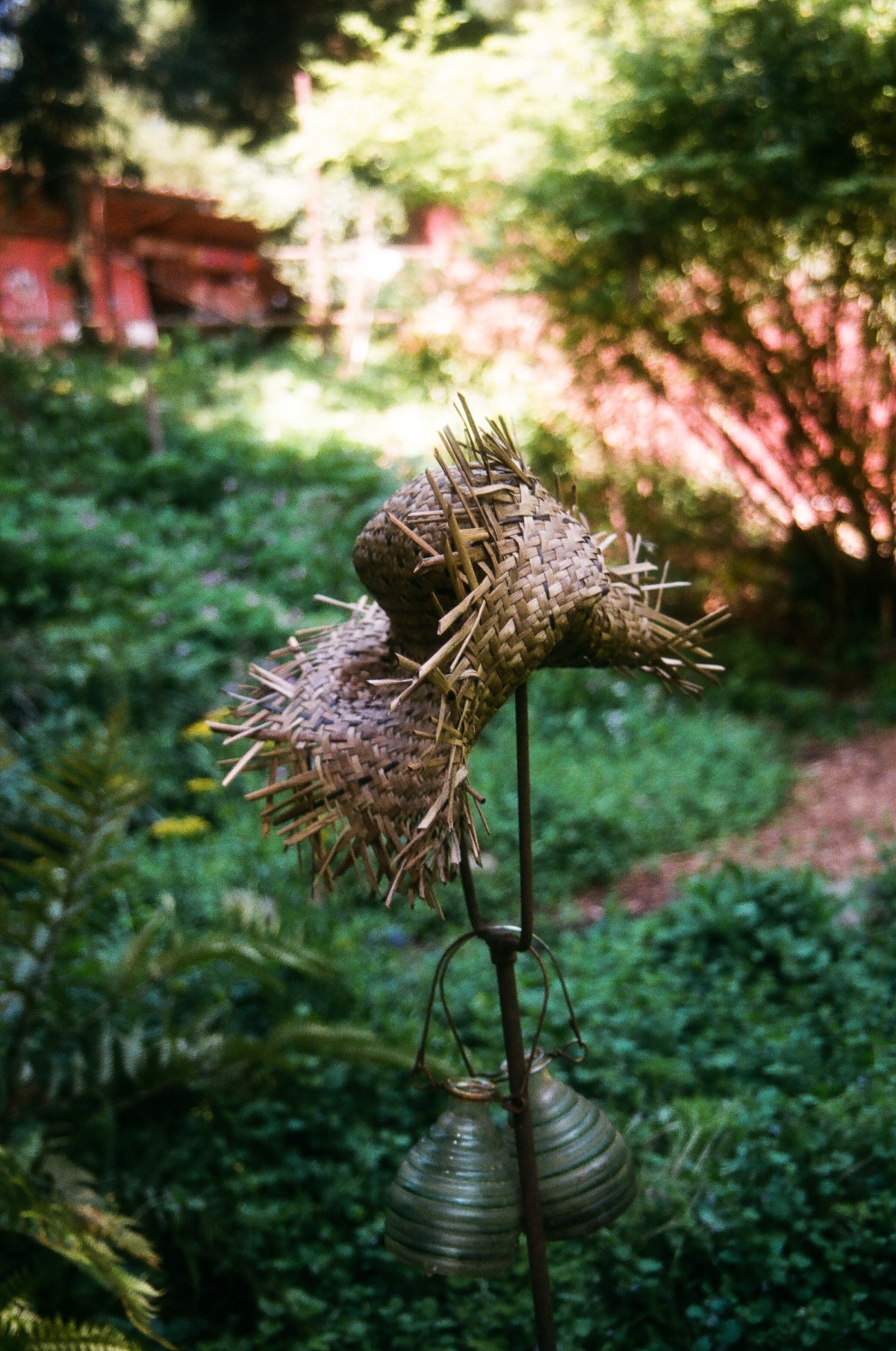The Pentax ZX-M
Nikon and Canon had already tried the formula with the Nikon F-601/N6006 and the Canon EF-M: take an autofocus camera and derive a flash-less and autofocus-less version of it. The goal was at the same time to please conservative clients adverse to auto-focus and to offer a cheaper entry to their line of modern cameras by removing the hardware associated to the autofocus system and the built-in flash.
Pentax had different motives. Their two entry-level manual focus SLRs had been on the market for a very long time (20 years for the K1000 and 12 years for the P3/P30) and were badly in need of a replacement. Technically, they had nothing in common with the Pentax autofocus cameras of the time, and even though they were now made in China, those very conventional all-metal, all glass cameras were probably more expensive to manufacture than modern entry level auto-focus cameras made out of plastic and relying heavily on electronics.
The ZX-M was the response to Pentax’s problem. Derived from the middle of the range auto-focus ZX-5 (*), the camera was not a stripper – in fact, it supported the usual PASM exposure modes and it offered all the functions needed by a photographer (exposure compensation dial, depth of field preview and exposure lock). Of course, it was motorized, but it was still incredibly compact, and at 305g, it will be remembered as the lightest 35mm film SLR ever, autofocus or not.

Its low weight was the result of the extended use of plastics (only the shutter blades are in metal), and of the adoption of a penta-mirror instead of the more conventional (but heavier) all glass pentaprism. Penta-mirrors are shunned by enthusiasts, because they make for less luminous viewfinders. In the case of the Pentax, the viewfinder is not only darker, but also narrower than its predecessor in the P3 – but it’s still usable.
As a true manual focus camera, the ZX-M also benefited from a relatively coarse grain focusing screen, with a ring of micro-prisms around a small split screen telemeter – which is more than the K1000 ever offered. A small greenish LCD display at the top right of the viewfinder showed the exposure parameters chosen by the automatism, and a bar graph to help determine the right exposure in semi-auto mode.

Ideally, it should be paired with Pentax’s KA manual focus lenses (the first evolution of the K lens mount, with electrical contacts to control the aperture), but it nonetheless offered the Aperture preferred automatic and semi-automatic exposure modes with older K lenses. It also works with more recent Pentax F and FA lenses, as long as they’re designed to cover the “full-frame”, and not the cropped sensor of most dSLRs.
In the field…
Paired with a lens like the Pentax-A 50mm f/2 or the Pentax-A 35-70 f/3.5-4.5, it forms an extremely light and compact combo, that the photographer can carry all day without any risk of back or neck pain.
The camera is small but all the commands are logically placed. The logic of the command is reminiscent of cameras of the early eighties – there is no PASM selector (for the auto-exposure mode) and the interface remains analog – the shutter speed knob and the aperture ring are fully functional, each with a green “A” position to set the camera in Aperture Priority, Shutter Priority, Program or Semi-Auto modes.
Metering did not convince me: it’s an area where the ZX-M is not aligned with the ZX-5, and where in my opinion de-contenting went too far: with KA, F and FA lenses the ZX-M relies on a very simplified matrix system with 2 zones only (there are 6 on the ZX-5), and with the original K lenses, it reverts to central weighted average metering. There is no way for the photographer to select the average metering mode, other than using a lens with the Pentax K original mount.

In my experience with other cameras (Nikon and Minolta in particular), matrix metering is extremely reliable, in part because it’s based on at least five metering zones. In the case of the ZX-M, I’m not sure that 2 zones are enough, and will provide anything different from a more conventional average center metering (some of the pictures I took with it were saved in post-processing by the exposure latitude of the Fujifilm 400 stock I was using, and a Nikon or a Minolta SLR of the same vintage would probably have done much better).
Now let’s talk about what really hurts: the viewfinder. It’s narrow and not as luminous as the competition’s. If we compare it to the viewfinder of cameras of a similar size, like an Olympus OM-2, a Canon AT-1, or even its predecessor the Pentax P3/P30, it’s clearly not in the same category (**). At the top of that, if your eye is not positioned correctly, you will be distracted by unpleasant reflections or aberrations. Very disappointing.


How much?
Plastic construction, lithium battery, so-so reputation – logic says it’s going to be cheap. And it is… It’s one of those cameras you can still get for less than $20.00.
Interestingly, the cameras for sale seem invariably to be in a very good condition – my bet is that having been bought at the very end of the film era, they were only used for a very short time before being replaced by digicams in the bags of photographers, and saw little use, or abuse.

As a conclusion
Its two predecessors – the K1000 and the P3, had been sales successes, with more than 3 million copies sold for each, over up to two decades. I could not find any figure for the ZX-M, but my guess is that it was not that successful.
On paper, the ZX-M has most of what an aspiring photographer needs. And contrarily to the previous generation of “learners cameras” (like its predecessor the K1000), it will let new photographers play with multiple auto-exposure modes and with a well implemented exposure lock. In the field, it’s not a bad camera – it’s super compact and super light, easy to use (because film loading and rewinding are taken care of by the camera’s motor), and will take good pictures with the right lens – provided you pay a little attention to the exposure.
The problem starts if you compare it with the P3n or the P3t, or in fact with any good “enthusiast oriented” SLR of the late seventies/early eighties. Those cameras are not motorized, they’re most probably missing the shutter preferred and the program auto exposure modes of the ZX-M, they’re slightly heavier, and they may be a few dollars more expensive on the second hand market. But they have a real pentaprism viewfinder, they’re still built primarily out of metal, they use very easy to find batteries, and the pictures they take will be at least as good. All in all, they’re more pleasant to use. In the Pentax family, the P30n or the Super-Program (Super-A) would be my choice. Sorry, ZX-M.
(*) in those days Pentax, like its three big competitors, was selling the same camera under different model names – depending on the geography. The ZX-M (US model) was known as the MZ-M in the rest of the world. Similarly, the P3 was the US name of the P30, ZX-5 the american name of the MZ-5. The cameras were otherwise identical.
One can assume it was being done to protect the local importers by making grey imports more visible.
(**) If I rank the viewfinders of manual SLRs from worst to best, the Fuji STX-2 ranks at the bottom, by far, followed by cameras of the sixties or early seventies. The ZX-M is much better than those ancient SLRs, but not as pleasant as the viewfinder of some cameras sold in the late seventies-mid eighties. If you exclude from the comparison the High Eyepoint viewfinder of the very large and very heavy “pro” cameras from Nikon, Canon or Contax ( F3, T90 and ST respectively), the Olympus OM-1 and OM-2 sit at the top of the list. The Canon A series (AT-1) and the Pentax P3 fare particularly well considering their size and their price when new. The focusing screen of the Nikon FE2 (and similarly spec’d Nikon cameras like the FA or the FM2) is finer and more luminous than what Canon and Pentax were proposing, but it’s narrower and more difficult to use for bespectacled photographers.
More about the Pentax MZ-M/ZX-M
https://lewiscollard.com/cameras/pentax-zx-m-mz-m/
More about Pentax cameras (including current digital SLRs):
http://www.pentax-slr.com/71760564
Shooting under lock-down….
The stay at home and lock down orders in Georgia have not been very stringent. Public parks were closed, but people could still walk freely on the streets, or play golf on greens like Bobby Jones’, which is located right in the middle of mid-town.
Having film processed took longer than usual (3 weeks), primarily because the US Postal service is slower than normal. But the film rolls did not get lost and were processed with the usual care by my go-to lab, the Old School Photo Lab.



